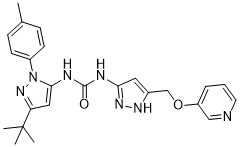
| 规格 | 价格 | 库存 | 数量 |
|---|---|---|---|
| 5mg |
|
||
| 10mg |
|
||
| 25mg |
|
||
| 50mg |
|
||
| Other Sizes |
|
| 靶点 |
PYK2 (IC50 = 637 nM)
|
|---|---|
| 体外研究 (In Vitro) |
在 hMSC 培养物中,PF-4618433(0.1-1.0 μM;7 天)可刺激成骨。 PF-4618433 以药物依赖性方式增加碱性磷酸酶 (ALP) 活性和矿化作用 [1]。在剂量为 0.1 和 0.3 μM 时,PF-4618433(0.0125-0.3 μM;14 或 21 天)可改善钙沉积 [2]。微米; 24小时)增加成骨细胞的增殖[2]。
|
| 酶活实验 |
结晶——使用5mg/ml的蛋白质储备实现了apo-PYK2、BIRB796、PF-431396和PF-4618433(PF-46)抑制剂的结晶。对于共结晶实验,使用抑制剂(来自30 mm的DMSO储备)使终浓度在0.5-1 mm之间。在标准Linbro板中的750μl孔溶液上设置2μl+2μl的悬滴,并在22°C下孵育。使用汉普顿筛进行的初步筛选产生了一种条件,0.1 m双Tris:pH 6.0-7.0,0.2 m MgCl2,20-27%PEG 3350,1 mm TCEP,通过优化条件以及多轮条纹和微晶种,得到了针状晶体。对于抑制剂共络合物结晶,将优化的晶体进一步浸泡在3mm抑制剂中过夜,以增加抑制剂的占有率[1]。
碱性磷酸酶(ALP)活性测定[2] BMSC以4×10~4个细胞铺板,在不同浓度的PF-43或PF-4618433 (PF-46)存在或不存在的情况下,用50μM抗坏血酸(AA)和5 mMβ-磷酸甘油酯(β-GP)分化为成熟成骨细胞7天。如前所述,通过向1.5 M碱性缓冲液中含有2 mg/mL对硝基苯磷酸盐的ALP底物中加入细胞裂解物来测定ALP活性。通过加入20mM NaOH停止酶反应,并使用分光光度计记录405nm处的吸光度。使用Pierce™BCA蛋白检测试剂盒通过总蛋白浓度使ALP活性标准化。实验一式三份,重复三次。 |
| 细胞实验 |
细胞增殖测定[2] 细胞
细胞类型:小鼠骨髓间充质干细胞 (BMSC) 测试浓度: 0.1, 0.3 μM 孵育持续时间:24小时 实验结果:与未处理组或对照组相比,细胞增殖活性显着增加。 |
| 参考文献 |
|
| 其他信息 |
Proline-rich tyrosine kinase 2 (PYK2) is a cytoplasmic, non-receptor tyrosine kinase implicated in multiple signaling pathways. It is a negative regulator of osteogenesis and considered a viable drug target for osteoporosis treatment. The high-resolution structures of the human PYK2 kinase domain with different inhibitor complexes establish the conventional bilobal kinase architecture and show the conformational variability of the DFG loop. The basis for the lack of selectivity for the classical kinase inhibitor, PF-431396, within the FAK family is explained by our structural analyses. Importantly, the novel DFG-out conformation with two diarylurea inhibitors (BIRB796, PF-4618433) reveals a distinct subclass of non-receptor tyrosine kinases identifiable by the gatekeeper Met-502 and the unique hinge loop conformation of Leu-504. This is the first example of a leucine residue in the hinge loop that blocks the ATP binding site in the DFG-out conformation. Our structural, biophysical, and pharmacological studies suggest that the unique features of the DFG motif, including Leu-504 hinge-loop variability, can be exploited for the development of selective protein kinase inhibitors.[1]
Pyk2 is a non-receptor tyrosine kinase that belongs to the family of focal adhesion kinases. Studies from our laboratory and others demonstrated that mice lacking the Pyk2 gene (Ptk2B) have high bone mass, which was due to increased osteoblast activity, as well as decreased osteoclast activity. It was previously reported that a chemical inhibitor that targets both Pyk2 and its homolog FAK, led to increased bone formation in ovariectomized rats. In the current study, we developed a hydrogel containing poly(ethylene glycol) diacrylate (PEGDA) and gelatin which was curable by visible-light and was suitable for the delivery of small molecules, including a Pyk2-targeted chemical inhibitor. We characterized several critical properties of the hydrogel, including viscosity, gelation time, swelling, degradation, and drug release behavior. We found that a hydrogel composed of PEGDA1000 plus 10% gelatin (P1000:G10) exhibited Bingham fluid behavior that can resist free flowing before in situ polymerization, making it suitable for use as an injectable carrier in open wound applications. The P1000:G10 hydrogel was cytocompatible and displayed a more delayed drug release behavior than other hydrogels we tested. Importantly, the Pyk2-inhibitor-hydrogel retained its inhibitory activity against the Pyk2 tyrosine kinase, and promoted osteoblast activity and mineral deposition in vitro. Overall, our findings suggest that a Pyk2-inhibitor based hydrogel may be suitable for the treatment of craniofacial and appendicular skeletal defects and targeted bone regeneration.[2] |
| 分子式 |
C24H27N7O2
|
|---|---|
| 分子量 |
445.52
|
| 精确质量 |
445.222
|
| 元素分析 |
C, 64.70; H, 6.11; N, 22.01; O, 7.18
|
| CAS号 |
1166393-85-6
|
| 相关CAS号 |
1166393-85-6
|
| PubChem CID |
25203958
|
| 外观&性状 |
White to off-white solid powder
|
| 密度 |
1.3±0.1 g/cm3
|
| 沸点 |
587.6±50.0 °C at 760 mmHg
|
| 闪点 |
309.2±30.1 °C
|
| 蒸汽压 |
0.0±1.6 mmHg at 25°C
|
| 折射率 |
1.649
|
| LogP |
4.86
|
| tPSA |
109.75
|
| 氢键供体(HBD)数目 |
3
|
| 氢键受体(HBA)数目 |
5
|
| 可旋转键数目(RBC) |
7
|
| 重原子数目 |
33
|
| 分子复杂度/Complexity |
635
|
| 定义原子立体中心数目 |
0
|
| SMILES |
O=C(NC1C=C(COC2C=NC=CC=2)NN=1)NC1=CC(C(C)(C)C)=NN1C1C=CC(C)=CC=1
|
| InChi Key |
NJARPUHZDSAXPL-UHFFFAOYSA-N
|
| InChi Code |
InChI=1S/C24H27N7O2/c1-16-7-9-18(10-8-16)31-22(13-20(30-31)24(2,3)4)27-23(32)26-21-12-17(28-29-21)15-33-19-6-5-11-25-14-19/h5-14H,15H2,1-4H3,(H3,26,27,28,29,32)
|
| 化学名 |
1-[5-tert-butyl-2-(4-methylphenyl)pyrazol-3-yl]-3-[5-(pyridin-3-yloxymethyl)-1H-pyrazol-3-yl]urea
|
| 别名 |
PF-4618433; PF4618433; 1-(3-(tert-butyl)-1-(p-tolyl)-1H-pyrazol-5-yl)-3-(3-((pyridin-3-yloxy)methyl)-1H-pyrazol-5-yl)urea; 1-[5-tert-butyl-2-(4-methylphenyl)-1,2-dihydro-3H-pyrazol-3-ylidene]-3-{3-[(pyridin-3-yloxy)methyl]-1H-pyrazol-5-yl}urea; CHEMBL1084269; 1-[5-tert-butyl-2-(4-methylphenyl)pyrazol-3-yl]-3-[5-(pyridin-3-yloxymethyl)-1H-pyrazol-3-yl]urea; PF 4618433
|
| HS Tariff Code |
2934.99.9001
|
| 存储方式 |
Powder -20°C 3 years 4°C 2 years In solvent -80°C 6 months -20°C 1 month |
| 运输条件 |
Room temperature (This product is stable at ambient temperature for a few days during ordinary shipping and time spent in Customs)
|
| 溶解度 (体外实验) |
DMSO: ~100 mg/mL (~224.5 mM)
|
|---|---|
| 溶解度 (体内实验) |
配方 1 中的溶解度: ≥ 2.5 mg/mL (5.61 mM) (饱和度未知) in 10% DMSO + 40% PEG300 + 5% Tween80 + 45% Saline (这些助溶剂从左到右依次添加,逐一添加), 澄清溶液。
例如,若需制备1 mL的工作液,可将100 μL 25.0 mg/mL澄清DMSO储备液加入到400 μL PEG300中,混匀;然后向上述溶液中加入50 μL Tween-80,混匀;加入450 μL生理盐水定容至1 mL。 *生理盐水的制备:将 0.9 g 氯化钠溶解在 100 mL ddH₂O中,得到澄清溶液。 配方 2 中的溶解度: ≥ 2.5 mg/mL (5.61 mM) (饱和度未知) in 10% DMSO + 90% (20% SBE-β-CD in Saline) (这些助溶剂从左到右依次添加,逐一添加), 澄清溶液。 例如,若需制备1 mL的工作液,可将 100 μL 25.0 mg/mL澄清DMSO储备液加入900 μL 20% SBE-β-CD生理盐水溶液中,混匀。 *20% SBE-β-CD 生理盐水溶液的制备(4°C,1 周):将 2 g SBE-β-CD 溶解于 10 mL 生理盐水中,得到澄清溶液。 View More
配方 3 中的溶解度: ≥ 2.5 mg/mL (5.61 mM) (饱和度未知) in 10% DMSO + 90% Corn Oil (这些助溶剂从左到右依次添加,逐一添加), 澄清溶液。 1、请先配制澄清的储备液(如:用DMSO配置50 或 100 mg/mL母液(储备液)); 2、取适量母液,按从左到右的顺序依次添加助溶剂,澄清后再加入下一助溶剂。以 下列配方为例说明 (注意此配方只用于说明,并不一定代表此产品 的实际溶解配方): 10% DMSO → 40% PEG300 → 5% Tween-80 → 45% ddH2O (或 saline); 假设最终工作液的体积为 1 mL, 浓度为5 mg/mL: 取 100 μL 50 mg/mL 的澄清 DMSO 储备液加到 400 μL PEG300 中,混合均匀/澄清;向上述体系中加入50 μL Tween-80,混合均匀/澄清;然后继续加入450 μL ddH2O (或 saline)定容至 1 mL; 3、溶剂前显示的百分比是指该溶剂在最终溶液/工作液中的体积所占比例; 4、 如产品在配制过程中出现沉淀/析出,可通过加热(≤50℃)或超声的方式助溶; 5、为保证最佳实验结果,工作液请现配现用! 6、如不确定怎么将母液配置成体内动物实验的工作液,请查看说明书或联系我们; 7、 以上所有助溶剂都可在 Invivochem.cn网站购买。 |
| 制备储备液 | 1 mg | 5 mg | 10 mg | |
| 1 mM | 2.2446 mL | 11.2228 mL | 22.4457 mL | |
| 5 mM | 0.4489 mL | 2.2446 mL | 4.4891 mL | |
| 10 mM | 0.2245 mL | 1.1223 mL | 2.2446 mL |
1、根据实验需要选择合适的溶剂配制储备液 (母液):对于大多数产品,InvivoChem推荐用DMSO配置母液 (比如:5、10、20mM或者10、20、50 mg/mL浓度),个别水溶性高的产品可直接溶于水。产品在DMSO 、水或其他溶剂中的具体溶解度详见上”溶解度 (体外)”部分;
2、如果您找不到您想要的溶解度信息,或者很难将产品溶解在溶液中,请联系我们;
3、建议使用下列计算器进行相关计算(摩尔浓度计算器、稀释计算器、分子量计算器、重组计算器等);
4、母液配好之后,将其分装到常规用量,并储存在-20°C或-80°C,尽量减少反复冻融循环。
计算结果:
工作液浓度: mg/mL;
DMSO母液配制方法: mg 药物溶于 μL DMSO溶液(母液浓度 mg/mL)。如该浓度超过该批次药物DMSO溶解度,请首先与我们联系。
体内配方配制方法:取 μL DMSO母液,加入 μL PEG300,混匀澄清后加入μL Tween 80,混匀澄清后加入 μL ddH2O,混匀澄清。
(1) 请确保溶液澄清之后,再加入下一种溶剂 (助溶剂) 。可利用涡旋、超声或水浴加热等方法助溶;
(2) 一定要按顺序加入溶剂 (助溶剂) 。
|
|